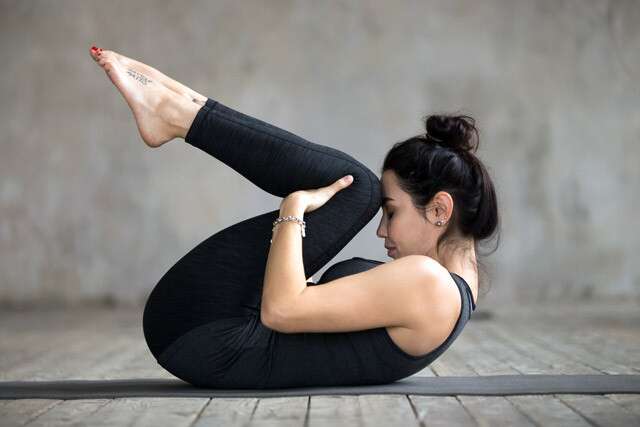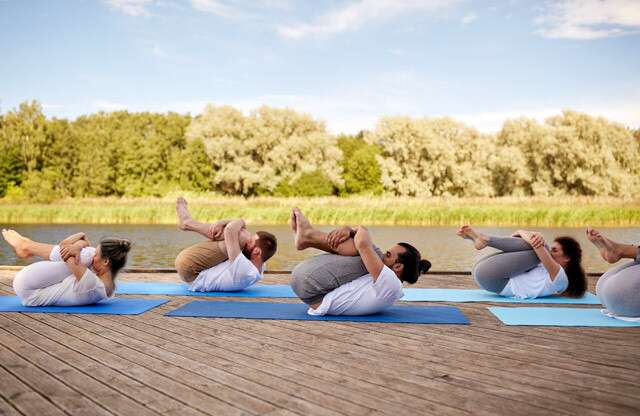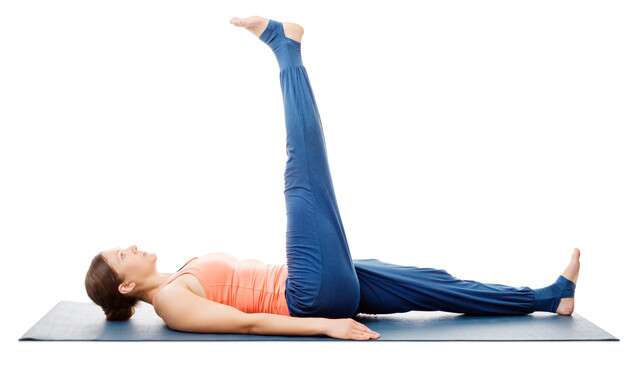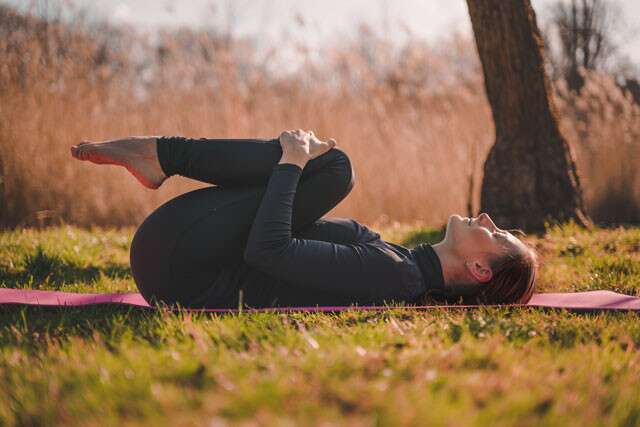The word "Pawanamuktasana" is made of two words, ‘Pawan’ which means wind and ‘Mukta', which translates to release. As the name suggests this asana helps in releasing the accumulated wind in our stomach and intestines. Pawanmuktasana helps reduce binge eating, improves mental health, regulates bowel movements and assists in weight loss.

Image: Shutterstock
How To Do Steps Pawanmuktasana Yoga Pose
Pawanmuktasana Preparatory Poses
Supta Matsyendrasana [Supine Spinal Twist Pose]
Ardha Pawanmuktasana [Half Wind Release Pose]
Pawanmuktasana Relaxing Yoga Poses
Benefits of Pawanmuktasana
Frequently Asked Questions (FAQs) About Pawanmuktasana
How To Do Steps Pawanmuktasana Yoga Pose
- Lie on your back or in a supine position, with your arms beside your body.
- Inhale.
- Exhale, bringing your knees toward your chest and pressing your thighs on your abdomen with clasped hands.
- Inhale again.
- As you exhale, raise your head off the floor, letting your chin touch your knees.
- Hold this pose as you take deep, long breaths in and out.
- Release the pose to return to the starting position, bringing your head down first and then your legs - this is one round.
- Do 2-3 rounds and then relax.

Image: Shutterstock
Pro-Tip: As you exhale, make sure that you tighten the grip of your hands on the knee and increase the pressure on the chest. As you inhale, loosen the grip.
Pawanmuktasana Preparatory Poses
The beauty of Pawanmuktasana as a pose is that it can be inculcated into every sequence, irrespective of the kind of sequence one is working at. This is a very simple way to get them back, neck, shoulders and legs in action easily, there is not much one can bring as a sequence before this pose. Yet we can do the following before the practice of this pose:
- Lying on the back, start by raising one leg at a time and rotate the ankles.
- Inhale and raise the left leg at 30 degrees and rotate the ankles.
- Slowly move it from 30 to 60 to 90 degrees and loosen the muscles around the ankles, thighs, calves and toes.
- Repeat the same with the other leg.
Pro Tip: When unwanted wind or gas is released, it helps the body move easily and thus brings the benefit of every pose.

Image: Shutterstock
Supta Matsyendrasana [Supine Spinal Twist Pose]
- While on your back, bend the legs at the knees and bring them to the chest. With a deep breath take both the knees to the left side twisting from the hip and bring it to the floor.
- Keep the arms stretched out to the side of you in line with your shoulders.
- This twisting of the hip along with the legs will help in opening the lower back thus working as a preparatory pose for Pawanamuktasana.
- Repeat with the other side.
Pro Tip: The deeper the twist, the deeper the stretch.
![Supta Matsyendrasana [Supine Spinal Twist Pose]](https://femina.wwmindia.com/content/2021/jul/yoga-041627302381.jpg)
Image: Shutterstock
Ardha Pawanmuktasana [Half Wind Release Pose]
- From the relaxed pose on your back, inhale and take the left leg at 90 degrees and bend the knee and bring it to the chest and hold with your hands.
- After a few breaths, raise the head and place the chin on the knee while the other leg is stretched out at 30 degrees from the floor.
- Repeat with the other leg and hold for a longer duration as breathing here in this pose is not as difficult as in Pawanamuktasana.
![Ardha Pawanmuktasana [Half Wind Release Pose]](https://femina.wwmindia.com/content/2021/jul/yoga-051627302393.jpg)
Image: Shutterstock
Pawanmuktasana Relaxing Yoga Poses
Pawanamuktasana is considered as both a simple and intermediate pose as the body is not stressed out much in this pose, but a lot of pressure is felt in the neck and chest region. In order to relax the muscles around the chest, neck and abdomen, one can follow it up with some simple relaxing poses. If the breathing is not practiced well in this pose, it can also bring strain to the head and the lungs, thus a few follow-up steps are imperative. Some of them are:Supta Baddha Konasana [Reclining Bound Angle Pose]:
- Release the pose of Pawanamuktasana and move into Reclining Bound Angle Pose.
- Here to give the hips and lower back some rest, place your feet in Namaste and place the arms to the side of you. In this pose, the lower back should be placed on the floor and not raised up in the air.
- Relax with a few breaths until you feel the need.
![Supta Baddha Konasana [Reclining Bound Angle Pose]](https://femina.wwmindia.com/content/2021/jul/yoga-061627302411.jpg)
Ardha Navasana [Half Corpse Pose]:
- Relax the entire body from Supta Baddha Konasana, by bending the knees and placing the feet on the floor.
- Keep some distance between the feet and knees and ensure the entire back is completely touching the floor and bring the focus of the breath to the abdominal muscles and back.
![Ardha Navasana [Half Corpse Pose]](https://femina.wwmindia.com/content/2021/jul/yoga-071627302433.jpg)
Matsyasana [Fish Pose]:
- Though this poses by itself is a little difficult for beginners, yet it brings a good relaxation to the neck and chest after Pawanamuktasana.
- The opposite flow of blood and the opposite bending of the neck improves the breathing which was otherwise put to stress during the pose of Pawanamuktasana.
![Matsyasana [Fish Pose]](https://femina.wwmindia.com/content/2021/jul/yoga-081627302452.jpg)
Savasana [Corpse Pose]:
- The complete body comes to rest in this pose which is done at the end of any sequence.
- Here one can practice this as a follow-up pose if one finds the breathing not relaxed.
- By completely bringing the body at ease, breathing comes at ease.
![Savasana [Corpse Pose]](https://femina.wwmindia.com/content/2021/jul/yoga-091627302470.jpg)
Image: Shutterstock
Benefits of Pawanmuktasana
- It strengthens abdominal muscles and reduces belly fat.
- It massages the intestines and other abdominal organs.
- It tones the arm, leg, and buttocks.
- It aids weight loss.
- It promotes digestion and relieves constipation.
- It strengthens the back.
- It enhances blood circulation in the hip joints.
- It eases tension, especially in the lower back.

Image: Shutterstock
Keep in mind: one should avoid doing this yoga pose if they have any of the following health issues - high blood pressure, hyperacidity, hernia, slip disc, heart problem, testicular disorder, neck and back issues. Women are advised to refrain from practicing Pawanmuktasana during pregnancy and menstruation.